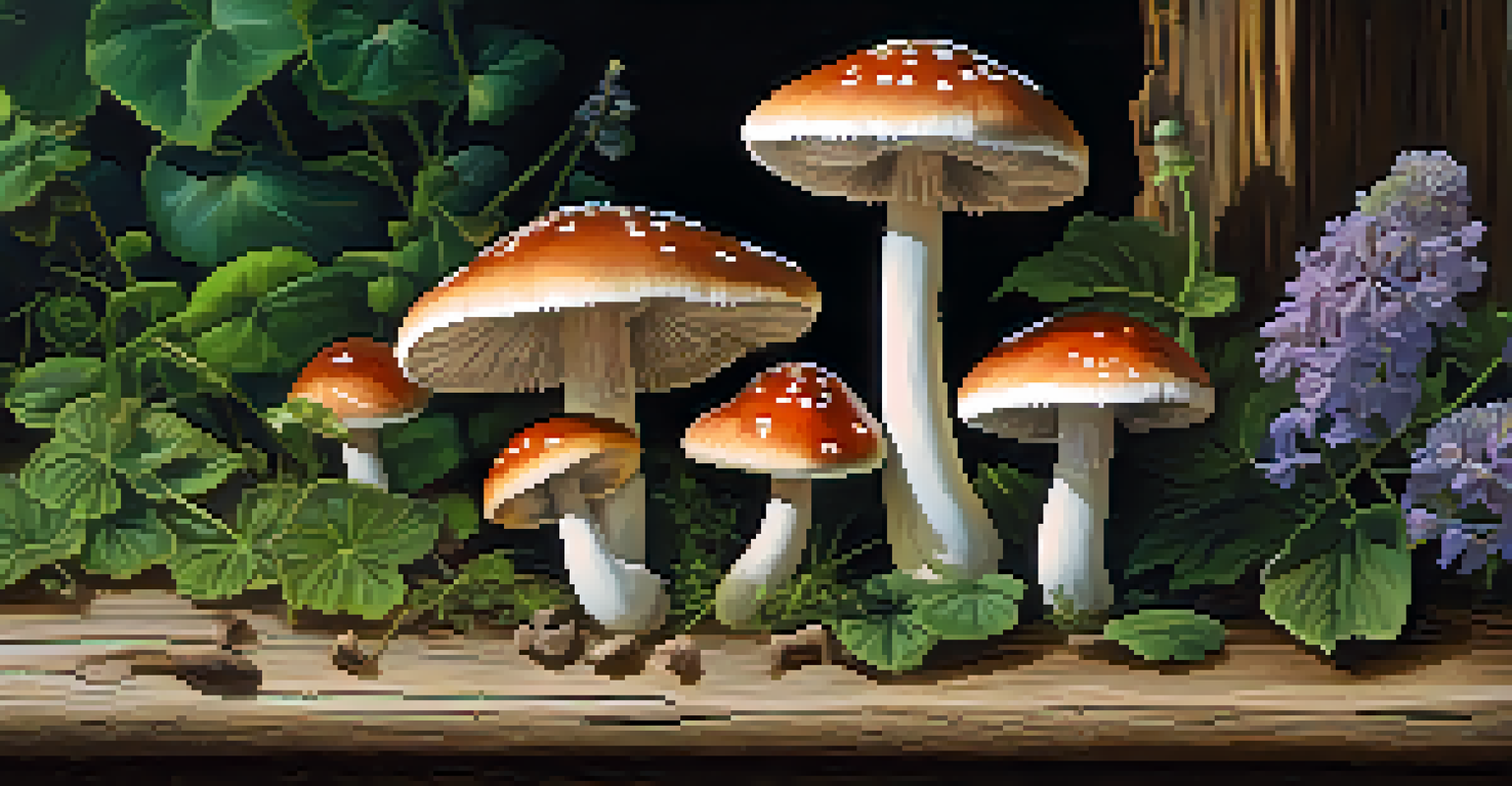Cultural Practices: Entheogens and Social Cohesion

Understanding Entheogens and Their Role in Culture
Entheogens are substances that, when consumed, facilitate altered states of consciousness, often used in spiritual or religious contexts. Many indigenous cultures have employed these substances for centuries, believing they connect them with the divine or enhance their communal experiences. Examples include ayahuasca in the Amazon and peyote among Native American tribes, which hold significant cultural and spiritual importance.
The experience of community is the experience of being connected to something larger than oneself.
These practices often involve rituals that are not just about the substance itself, but also about the community that gathers to partake. This communal aspect emphasizes shared experiences, forging deeper connections among participants. As these substances induce profound introspection and emotional release, they can strengthen the social fabric of the group.
Moreover, the use of entheogens has sparked interest worldwide, with many seeking to explore their potential for healing and personal growth. As a result, these substances are increasingly integrated into modern wellness practices, showcasing a blend of ancient traditions and contemporary society.
Rituals: The Heart of Entheogenic Experiences
Rituals surrounding the use of entheogens are crucial for setting the tone and intention of the experience. They often include elements like music, dance, and storytelling, which enrich the atmosphere and encourage participants to let go of their inhibitions. In many cultures, these rituals are led by a shaman or spiritual guide, who plays a vital role in nurturing the group's emotional safety.

The structure of these rituals can vary widely, but they typically follow a pattern that enhances collective engagement. For instance, participants might start with a circle to share intentions, followed by the consumption of the entheogen, and culminate in a period of reflection. This guided approach helps participants navigate their journeys together, fostering a sense of unity.
Entheogens Enhance Spiritual Connection
Entheogens have been used in various cultures to foster a deeper connection with the divine and enhance communal experiences.
The shared experience during these rituals often leads to transformative moments that can redefine relationships and personal perspectives. As individuals confront their fears and joys in a supportive environment, they emerge not only with insights but also with a stronger bond to their community.
Social Cohesion: Building Bonds Through Shared Experiences
The use of entheogens can significantly enhance social cohesion, as the shared experiences create a sense of belonging among participants. When individuals engage in these practices together, they often feel a heightened connection to one another, transcending the barriers of everyday life. This collective journey can foster empathy and understanding, which are essential components of a healthy community.
Healing requires from us to stop struggling, but to enjoy life more and endure it less.
As participants navigate their inner landscapes, they often share vulnerabilities and insights that deepen their relationships. This openness cultivates trust and encourages ongoing dialogue, making it easier for individuals to support one another beyond the ritual context. Consequently, bonds formed during these experiences can lead to long-lasting friendships and networks of support.
Additionally, the communal aspect of entheogenic use can help individuals feel less isolated in their struggles. By coming together to explore their thoughts and emotions, participants create a community that values shared growth and healing, reinforcing the notion that they are not alone in their journeys.
Cultural Variations: Diverse Practices and Beliefs
Around the world, different cultures have unique practices and beliefs surrounding entheogens, reflecting their values and traditions. For instance, the use of psilocybin mushrooms in certain Mexican communities is intertwined with ancient rituals and agricultural cycles, highlighting the connection between spirituality and nature. In contrast, some contemporary movements in the West have adopted these substances for personal development, often stripping away traditional contexts.
These variations underscore how cultural backgrounds shape the interpretation and significance of entheogenic experiences. While some cultures view these substances as sacred tools for spiritual insight, others may see them as means for self-exploration or therapy. Such differences can enrich the conversation about entheogens, providing multiple perspectives on their potential benefits and risks.
Rituals Foster Social Cohesion
Participating in rituals involving entheogens strengthens bonds among individuals, promoting empathy and understanding within communities.
Furthermore, as globalization continues to influence cultural exchanges, there is a growing interest in the integration of these practices into mainstream wellness. This blending can sometimes lead to misunderstandings or appropriation, making it crucial to approach these traditions with respect and awareness of their origins.
Therapeutic Potential: Healing Through Entheogenic Practices
Recent research has begun to uncover the therapeutic potential of entheogens, particularly in treating mental health issues such as depression and PTSD. Many individuals report transformative experiences that lead to significant emotional breakthroughs, often attributed to the communal aspect of the rituals. These insights can provide a fresh perspective on personal challenges and contribute to healing.
Therapeutic settings that incorporate entheogens often aim to replicate the communal dynamics found in traditional rituals. By fostering a safe space for exploration and connection, therapists can help individuals navigate their experiences while also benefiting from the support of peers. This combination of individual and group therapy can enhance the overall efficacy of treatment.
While more research is needed to fully understand the implications of these practices, the early findings are promising. As society moves toward a more holistic approach to mental health, the integration of entheogens into therapeutic frameworks may offer new pathways for healing and growth.
Challenges and Ethical Considerations in Entheogenic Practices
Despite the potential benefits, the use of entheogens raises various challenges and ethical considerations. Issues such as cultural appropriation, commercialization, and the safety of unregulated use can complicate the landscape. It's essential for individuals and communities to approach these practices with respect for their origins and the traditions that surround them.
Furthermore, the unregulated use of entheogens can lead to negative experiences if not conducted within a supportive framework. Participants may face psychological distress or confusion if they lack guidance or community support. This highlights the importance of education and preparation, ensuring that individuals understand the risks and responsibilities involved.
Therapeutic Benefits Are Emerging
Recent studies suggest that entheogens may offer therapeutic potential for mental health issues, providing emotional breakthroughs in supportive settings.
As the popularity of entheogens grows, the need for ethical practices becomes increasingly urgent. Establishing guidelines and fostering respectful dialogue can help navigate these challenges, ensuring that the benefits of entheogens are accessible in a safe and responsible manner.
The Future of Entheogens in Cultural and Therapeutic Contexts
Looking ahead, the role of entheogens in cultural and therapeutic contexts is likely to expand. As more people become aware of their potential benefits, there may be a resurgence of interest in traditional practices alongside contemporary therapeutic applications. This dual approach could lead to a richer understanding of how entheogens can contribute to personal and communal well-being.
Moreover, ongoing research into the therapeutic use of entheogens can provide valuable insights into their efficacy and safety. As scientific findings continue to emerge, they may influence public perception and policy, paving the way for more widespread acceptance and integration of these practices. This shift could ultimately lead to a more compassionate approach to mental health and personal growth.

In conclusion, the exploration of entheogens within cultural practices holds immense potential for fostering social cohesion and individual healing. By honoring the traditions that inform these practices and embracing their therapeutic possibilities, communities can create spaces for connection, understanding, and transformation.